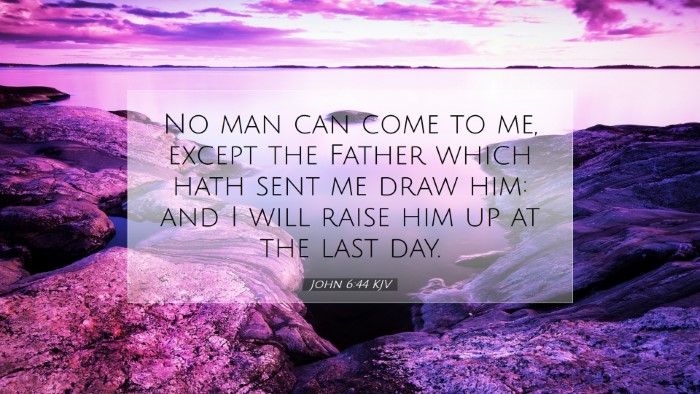Commentary on John 6:44
“No man can come to me, except the Father which hath sent me draw him: and I will raise him up at the last day.”
This verse is pivotal in understanding the doctrines of divine election, the necessity of divine grace, and the response of human will in salvation. The insights from historical commentaries shed light on these theological truths.
Divine Drawings as a Necessity
Matthew Henry notes that the words of Christ reveal that the initiative in coming to Him rests with the Father. He emphasizes that without divine drawing, humans are utterly incapable of approaching Christ. This concept of ‘drawing’ conveys the idea of an inner compulsion or irresistible influence that one experiences when the Spirit of God works in their heart, leading them toward faith.
Henry further elaborates that this drawing is not merely external persuasion; it is an internal change wrought by the Holy Spirit. The very essence of this drawing is rooted in God’s sovereign choice, exemplifying His grace that precedes any human endeavor towards Him. The implication is significant: humans, in their natural state, are spiritually dead and unresponsive to the call of Christ without the awakening influence of the Father.
The Role of God the Father in Salvation
Albert Barnes comments on the relationship between the Father’s drawing and the necessity of belief in Christ for salvation. He emphasizes that while God’s drawing is essential, it does not override human responsibility or the free offer of salvation. Barnes articulates that “drawing” implies both an attraction towards God and an awakening within men that enables them to respond to His invitation.
Moreover, Barnes points out that this divine drawing can occur through various means, including preaching, reading Scripture, and the natural revelations of God’s creation. This perspective highlights God as actively involved in the lives of individuals, seeking them for redemption. Barnes maintains that such drawing does not eliminate the necessity of personal faith; rather, it assures that those drawn will indeed come to Christ.
Resurrection Assurance
Both Matthew Henry and Albert Barnes note the promise of resurrection at the last day as a vital aspect of this verse. Henry indicates that this assurance connects believers’ current experience of faith with the future reality of resurrection. Christ’s commitment to raise those who are drawn to Him signifies not only the power of God in salvation but also the hope of eternal life that is extended to all who come to Him.
Adam Clarke expands on this idea by linking the resurrection to the profound mystery of spiritual life. Clarke asserts that the act of drawing signifies God's purpose to restore and bring life not just in a spiritual sense, but also in the physical resurrection of the body. This dual aspect of resurrection serves both as a guarantee to believers and an anticipation of the culmination of God’s redemptive plan.
The Interplay of Grace and Human Response
As we ponder the implications of John 6:44, it becomes clear that the relationship between divine grace and human response is central to the Christian faith. Henry’s commentary suggests that while God’s choosing and drawing are sovereign acts, there exists a responsibility upon the individual to respond in faith. This interaction portrays a harmonious balance between God’s sovereignty and human agency.
Barnes reinforces this by stating that the drawing of the Father is a gracious opportunity rather than a coercive force. It invites pastors, theologians, and scholars to reflect on their own understanding of grace—seeing it as a divine pull that woos the heart rather than forces compliance.
Theological Implications for Ministry
Understanding this verse has significant implications for pastoral ministry and evangelism. The call to preach the gospel must be anchored in the truth that salvation is an act of God’s grace, compelling pastors to depend on divine assistance in their ministry. Both Henry and Barnes encourage a posture of prayerful reliance upon God to draw those who hear the Word of God. The assurance of the Father’s drawing should embolden evangelistic efforts, knowing that the outcomes are anchored in God’s powerful will.
Furthermore, reflecting on the assured promise of resurrection invites believers to live with a future perspective. Clarke’s emphasis on the holistic nature of salvation challenges believers to see their faith as not only for present assurance but also for future hope. This invites a lived theology of hopefulness and anticipation in the community of believers.
Conclusion
In conclusion, John 6:44 serves as a foundational scripture that encapsulates the complexity of God's divine sovereignty in the drawing of humanity towards salvation through Christ. The insights offered by Matthew Henry, Albert Barnes, and Adam Clarke together create a rich tapestry of understanding regarding the nature of divine grace, human response, and the comprehensive promise of resurrection. This passage challenges us to reflect deeply on the nature of our faith and the divine initiatives that pursue a lost world.
Key Takeaways
- The necessity of divine drawing for the realization of faith in Christ.
- The relationship between God's sovereignty and human responsibility in the process of salvation.
- The assurance of resurrection serves as a powerful motivator for believers to share their faith.
- Ministry should be approached with a reliance on God's drawing power and grace, recognizing our role in proclaiming the gospel.


